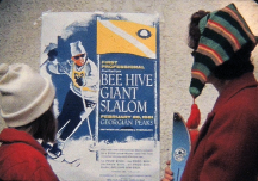
From 1961 through 1967, the annual Bee Hive giant slalom competition attracted the world’s top professional racers to Canada.
By Caroline Forcier Holloway
On March 7, 2014, the Georgian Peaks ski area in Ontario hosted its annual Super GP Classic, a team giant slalom race on the intermediate Minute Mile trail. Located near the town of Collingwood and overlooking Lake Huron’s Georgian Bay, this private alpine club offers 24 trails with a vertical rise of 820 feet, the highest in the province.
Though the GP Classic is an amateur event, open only to club members, it recalls a little-known but interesting chapter in racing history. On February 26, 1961, Georgian Peaks hosted the inaugural Bee Hive giant slalom. It was the first professional GS race in Canada and a smashing success, attracting elite racers like Stein Eriksen, Othmar Schneider, Ernie McCulloch and Anderl Molterer. For the next six years, top pro racers from Europe and North America convened in Canada to race on the Bee Hive circuit.
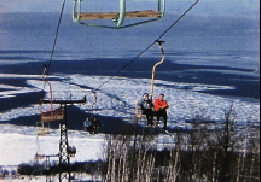 Skiers ride the double chair at Georgian Peaks in Ontario on the day of the event. All frame enlargements courtesy Library and Archives Canada, Dan Gibson Fonds, Bee Hive Films No. 1, 4 and 7.
Skiers ride the double chair at Georgian Peaks in Ontario on the day of the event. All frame enlargements courtesy Library and Archives Canada, Dan Gibson Fonds, Bee Hive Films No. 1, 4 and 7.The event was named after Bee Hive Golden Corn Syrup, an energy food manufactured by the St. Lawrence Starch Company of Port Credit, Ontario, the event sponsor. A Montreal Gazette article published in February 1962, following the second annual Bee Hive, reported that “to those who watched this spectacular and successful event, it was evident that professional ski racing had arrived to stay.” It also established Georgian Peaks as a training ground for Olympic-caliber Canadian alpine racers, including Judy Crawford (who placed fourth in women’s slalom at the 1972 Winter Games in Sapporo), Todd Brooker (who raced on the World Cup from 1981 to 1987 and is now a TV ski-racing commentator) and Brian Stemmle (who competed in four Olympics, from 1988 through 1998).
The driving force behind the first Bee Hive was Ian Rogers, a Toronto lawyer who founded Georgian Peaks in 1960. A key partner was the late Dan Gibson, a portrait photographer, budding filmmaker and avid skier, who was keen on promoting skiing in Collingwood and at Georgian Peaks. Sponsorship was easily secured through Gibson’s skiing friend Lorne Gray, of the St. Lawrence Starch Company. Through its signature Bee Hive corn syrup, the company was already sponsoring national and local sports events, including the National Hockey League. (At the time, corn syrup was a regular staple on breakfast tables, to pour on pancakes or addto your coffee.) The company’s role in the annual GS event included covering the competitors’ expenses, putting up the prize money, and advertising and promoting the race. And every year, a comely “Miss Bee Hive” was on hand to award medals and give each competitor a free can of corn syrup, which the racers drank (as seen in the films). Gibson documented the races and distributed his films for free, to promote the event and the sport of alpine racing—and skiing—across Canada (see “To Learn More”).
The First Bee Hive: Stein Eriksen Wins the Prize
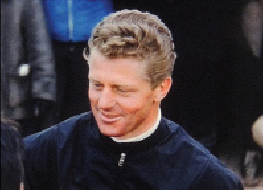 Stein Eriksen won the first Bee Hive in 1961.
Stein Eriksen won the first Bee Hive in 1961. The 1961 inaugural Bee Hive attracted some of the biggest names in ski racing. Stein Eriksen, the Norwegian superstar who had won a gold medal in GS and silver in slalom at the 1952 Winter Games, took first place. Anderl Molterer of Austria, also known as the “Blitz from Kitz,” took second. Fellow Austrian racers Christian Pravda and Othmar Schneider came in third and fourth, respectively. According to Red McConville, the former president of the Canadian Ski Association who raced in the 1964 Bee Hive, Toni Sailer, the world champion racer from Austria, was present for the first Bee Hive, but didn’t compete due to his new career as an actor. In Gibson’s film, he is seen congratulating the Bee Hive winners. In total, 23 competitors raced in the inaugural Bee Hive, including Canadian champion Ernie McCulloch of Mont Tremblant, Québec.
A newspaper headline of the day reads: “The real heroes of the race, however, didn’t wear skis.” This is a nod to the race organizers and volunteers, who ensured that the race would happen despite poor conditions that almost caused its cancellation. For a week before the race, unusually mild temperatures, mixed with rain and a lack of snow, made for almost non-existent skiing at Georgian Peaks. Officials refused to give in, spending upwards of $3,000 hauling snow by the truckload in the days before the race. On the night before the event, chemical snow cement was used to harden the snow around the slalom gates, and snow was funnelled onto the course through coal chutes. Skiers, local workers, high school students and residents of Collingwood, Thornbury and Clarksburg pitched in to help pack and shovel snow.
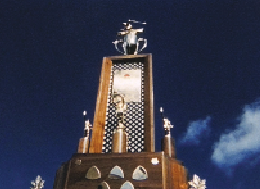
The racers were discouraged by the condition of the trail, but on race day, the overnight rain had turned into freezing sleet and the course was lightning fast. By noon, the sun had melted some of the ice and turned the surrounding dirt into mud, making it difficult for skiers and spectators to maneuver.
First-person recollections recount the challenges faced by the first Bee Hive race organizers. In particular, Helen Gibson of Toronto, Dan Gibson’s widow, recalls: “The day before the race there was a disastrous thaw to bare grass. Snow was trucked in, and many helpers shoveled it onto the mountain to make a single track down the course, which froze overnight so the race could be held. (What) a miracle!” She was one of more than 9,000 enthusiastic spectators who lined the course to watch the event.
Many others recall vivid memories of the first Bee Hive: the “February Thaw” and the difficult course conditions, the excitement of the race, billeting the racers, and the fine reception at the end of the day at a private home in Collingwood, where a select few had the rare opportunity to meet and mingle with the world’s skiing greats, including Eriksen, the star of the day.
Six More Years on the Circuit
The Second Annual Professional Invitation Bee Hive Giant Slalom was held at Mont Gabriel, in Québec`s Laurentian Mountains, on February 25, 1962. With the sponsor offering a larger total cash purse of $5,000, the event attracted even more pros. By changing the location, organizers hoped to promote professional ski racing across Canada and allow greater exposure for the sponsor. The race was held on O’Connell’s Slip (Scott’s Slip), a 4,000-foot-long trail that was reconstructed to make it steeper and tougher, and the resort used the event to promote its state-of-the-art grooming and snowmaking ability. Heli Schaller of Austria was the 1962 champion.
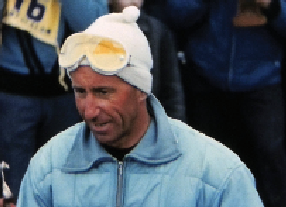 Christian Pravda
Christian Pravda
The Third Bee Hive challenge was held at Devil’s Glen, near Collingwood, on February 10, 1963. Twenty-five pros raced on a course set by Red McConville, the Devil’s Glen co-founder. The champion that year was Ernst Hinterseer of Austria, who had won slalom gold and GS bronze at the 1960 Olympics. Hinterseer returned to Devil’s Glen in 1964 to win the fourth Bee Hive. This race included three of the world’s leading skiers: Egon Zimmermann, François Bonlieu and Pepi Stiegler, who won GS bronze and slalom gold that year at the Innsbruck Olympics. Other veteran professionals competing at Devil’s Glen included Anderl Molterer, Adrien Duvillard, Pepi Gramshammer, Christian Pravda and Heli Schaller.
The following year, the Bee Hive headed west for the fifth annual race held on March 13, 1965 at Mount Whitehorn in Lake Louise, Alberta. Twenty skiers competed for the trophy including five talented Canadians (Jean Carpentier, Bob Gilmour, Jim McConkey, Al Menzies and Lorne O’Connor).
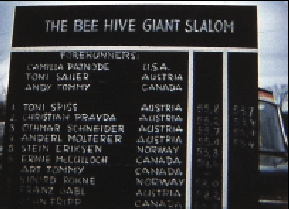 The first Bee Hive GS attracted some of the world’s top ski racers, including Othmar Schneider and Christian Pravada (pictured above).
The first Bee Hive GS attracted some of the world’s top ski racers, including Othmar Schneider and Christian Pravada (pictured above).
They competed against other world-class racers, including Mike Wiegele, Toni Spiess, Christian Pravda, Pepi Gramshammer, Marvin Moriarty and that year’s Bee Hive champion, Adrien Duvillard from France. The Sixth Bee Hive was set in Eastern Canada, at Lac Beauport, Québec, on February 13, 1966, with
Ernst Hinterseer capturing first place for the third time. He completed the two-run race with a total time of 2:34.366, and Gramshammer placed second with a time of 2:34.735. The race comprised 42 gates and covered 2,200 feet over a vertical drop of 700 feet. Altogether, the race included 23 racers with 10 racers from Austria, 10 from Canada, two racers from France and one from the United States (Moriarty).
According toCanadian Sport Monthly, much attention was placed on the timing mechanism used to clock the Sixth Bee Hive race: a new Heuer timer from Switzerland. “The device is so revolutionary that on the day before the race our officials were still trying to figure it out,” said sponsor Lorne Gray. It offered reliability and accuracy down to one-thousandth of a second.
The seventh and final Bee Hive was moved to Mont Tremblant, Québec, and held on March 12, 1967. Hias Leitner from Austria, silver medalist in the 1960 Winter Olympics, took first place. The film by Dan Gibson offers a record of the racers in action—some in slow motion to showcase their technique and ability—including Herman Goellner, Toni Spiess, Egon Zimmermann, Anderl Molterer and others.
No one can say for certain why the Bee Hive series ended after a successful seven-year run. Some believe that competitors were asking for more than the sponsor could provide in an overall purse of $5,000, with $2,000 going to the race champion each year. Others say the Bee Hive had a good run and simply died a natural death. Regardless of the speculations, most agree that after Lorne Gray’s untimely death in 1969, the momentum was impossible to regain.
Caroline Forcier Holloway is an archivist, a former CSIA instructor and an avid skier. She lives in Ottawa, Ontario.
